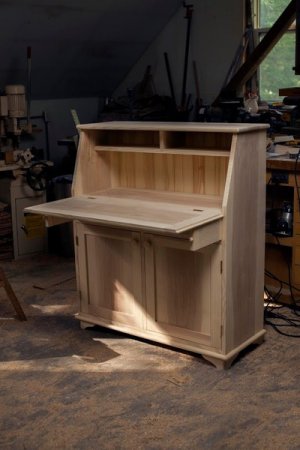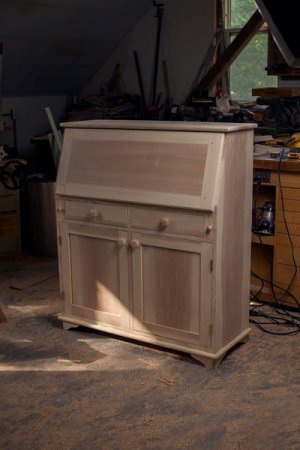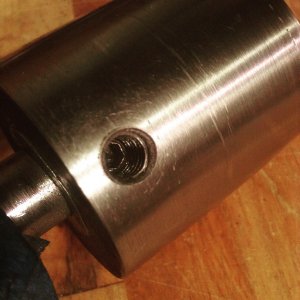-
Welcome back Guest! Did you know you can mentor other members here at H-M? If not, please check out our Relaunch of Hobby Machinist Mentoring Program!
- Forums
- THE PROJECTS AREA
- PROJECT OF THE DAY --- WHAT DID YOU DO IN YOUR SHOP TODAY?
- Project of the Day Mega-Thread Archives
You are using an out of date browser. It may not display this or other websites correctly.
You should upgrade or use an alternative browser.
You should upgrade or use an alternative browser.
2016 POTD Thread Archive
- Thread starter sanddan
- Start date
F
Firestopper
Forum Guest
Register Today
Built a 6" x 14" shelf to store two medium sized oil cans. I used 16 gauge and broke four sides. The rear lip (mounting lip) was kept at 1-1/4" while the rest of the shelf has a .750" lip. The rounded corners required two strips to be formed and welded. The shelf will be mounted to a lathe stand just below the tail stock. Also beefed up some angle brackets with gussets (left over from different job) that will be used for castors on smaller mill.
Laid-out the scrap sheet for cutting and breaking. Used those inexpensive HF hand shear for cutting sheet and rounded corners.
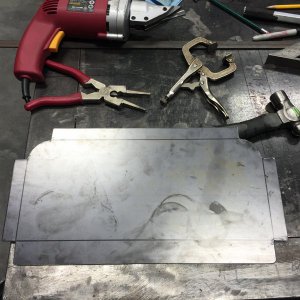
The 8' apron brake used is a WW II era break, heavy as hell and american made. Breaking sequence is critical as this is a fingerless brake. On this particular job, if I was to break the sides first, then the back brake would not be possible as the sides would conflict at 60-70º. The back (1-1/4" lip) was done first, then the sides. The ends of the brake where used to bend the right side and left side. The front lip doesn't care as the corner radius had no lips.
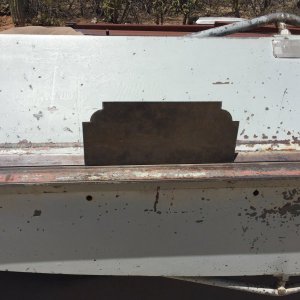
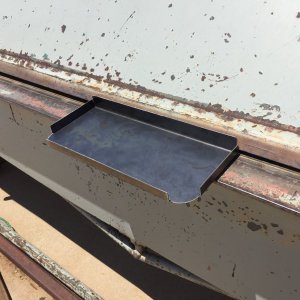
A 3/4" strip was sheared and kept long (enough for both corners) for forming the corners.
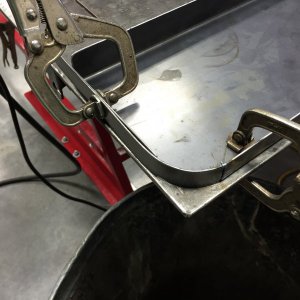
Corners where formed and tacked from the top and welded from the bottom, then ground smooth for a one piece look. Remember to smooth out all edges prior to breaking, eliminating the sharp edge a shear leaves behind.
The gussets where uneventful but I should note angle brakets where galvanized coated under the painted surface. Any hot work done on galvanized should be cleaned off. Grinding,sanding etc should be done in a well ventilated area.
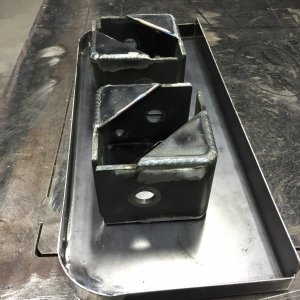
Turned out nice and should work well for intended use. Even the simplest jobs take some time to complete.
Stay cool.
Paco
Laid-out the scrap sheet for cutting and breaking. Used those inexpensive HF hand shear for cutting sheet and rounded corners.

The 8' apron brake used is a WW II era break, heavy as hell and american made. Breaking sequence is critical as this is a fingerless brake. On this particular job, if I was to break the sides first, then the back brake would not be possible as the sides would conflict at 60-70º. The back (1-1/4" lip) was done first, then the sides. The ends of the brake where used to bend the right side and left side. The front lip doesn't care as the corner radius had no lips.


A 3/4" strip was sheared and kept long (enough for both corners) for forming the corners.

Corners where formed and tacked from the top and welded from the bottom, then ground smooth for a one piece look. Remember to smooth out all edges prior to breaking, eliminating the sharp edge a shear leaves behind.
The gussets where uneventful but I should note angle brakets where galvanized coated under the painted surface. Any hot work done on galvanized should be cleaned off. Grinding,sanding etc should be done in a well ventilated area.

Turned out nice and should work well for intended use. Even the simplest jobs take some time to complete.
Stay cool.
Paco
Last edited by a moderator:
F
f350ca
Forum Guest
Register Today
- Joined
- Mar 12, 2014
- Messages
- 1,531
Built a 6" x 14" shelf to store two medium sized oil cans. I used 16 gauge and broke four sides. The rear lip (mounting lip) was kept at 1-1/4" while the rest of the shelf has a .750" lip. The rounded corners required two strips to be formed and welded. The shelf will be mounted to a lathe stand just below the tail stock. Also beefed up some angle brackets with gussets (left over from different job) that will be used for castors on smaller mill.
Laid-out the scrap sheet for cutting and breaking. Used those inexpensive HF hand shear for cutting sheet and rounded corners.
View attachment 131260
The 8' apron brake used is a WW II era break, heavy as hell and american made. Breaking sequence is critical as this is a fingerless brake. On this particular job, if I was to break the sides first, then the back brake would not be possible as the sides would conflict at 60-70º. The back (1-1/4" lip) was done first, then the sides. The ends of the brake where used to bend the right side and left side. The front lip doesn't care as the corner radius had no lips.
View attachment 131261 View attachment 131262
A 3/4" strip was sheared and kept long (enough for both corners) for forming the corners.
View attachment 131263
Corners where formed and tacked from the top and welded from the bottom, then around smooth for a one piece look. Remember to smooth out all edges prior to breaking, eliminating the sharp edge a shear leaves behind.
The gussets where uneventful but I should note angle brakets where galvanized coated under the painted surface. Any hot work done on galvanized should be cleaned off. Grinding,sanding etc should be done in a well ventilated area.
View attachment 131264
Turned out nice and should work well for intended use. Even the simplest jobs take some time to complete.
Stay cool.
Paco
Looks great Paco. I sure with I had enough room for a small brake and shear but unfortunately I am busting at the seams as is. It would be great for small projects like you just posted.
Mike.
- Joined
- Dec 27, 2014
- Messages
- 4,056
For me (an amateur wood worker) that is an awesome desk. My GGF left a similar, (deeper, shorter) cherry slant top desk, another member of the family got it, but I drew it off first, have (slim) hopes of reproducing it.
- Joined
- Apr 21, 2015
- Messages
- 894
You guys are making me jealous again, of your skills, resources, and time. When someone asks me what I do I sometimes explain that I'm a retired guy at heart. Unfortunately I'm far from retired, and I have four kids under age 12 (not unfortunate, just a major time factor). Eventually I'll get there. For now I take pleasure in the little things, like drilling through my drive wheel sandwich and motor shaft, tapping it to 5/16"-18, and loctite-ing in a couple of setscrews torqued against each other. No way it will unscrew itself now. And a reasonable amount of work to get done between going out to eat with the family and watching Voltron together before bed .
- Joined
- Apr 21, 2015
- Messages
- 894
- Joined
- Apr 21, 2015
- Messages
- 894
I got spoiled at a shop where I worked a few years ago. Two cast iron 10' manual brakes (10' is standard for architectural sheet metal work), one 10' CNC brake (oldschool CNC, read from a floppy disk a routine set up on software that has long since been abandoned, but fortunately they're still using the same standard profiles they were 20-30 years ago, and they have a couple extra copies of the floppy), a 10' press brake, a 48" finger brake, a Pittsburgh seamer, and a 10' hydraulic shear. Also a couple of roll formers for seamless panels and 6" commercial gutters. My family has the biggest gutters in each of their neighborhoods.The 8' apron brake used is a WW II era break, heavy as hell and american made. Breaking sequence is critical as this is a fingerless brake.
Now I'm looking at building an 18" brake (because I have a piece of D2 tool steel that is perfect for one, and because I've been wanting to make one since I left that shop), and it will be nice to have, but there's nothing like having the real machines. Then again in the three years since I worked there I think I've developed more skills at fabricating what I need without those machines than most the guys there if they didn't have them. I still have a lot to learn, but there's nothing like needing to make the tools you have do the job you need to help you understand the materials better than just memorizing the sequence of operations on a dedicated machine.
OK, who is it?
Hobbymetalkits.com
Owned by a fellow named Bernie McCallum. Treats me right. I think he started Speedy Metals years ago but left and started another company.


